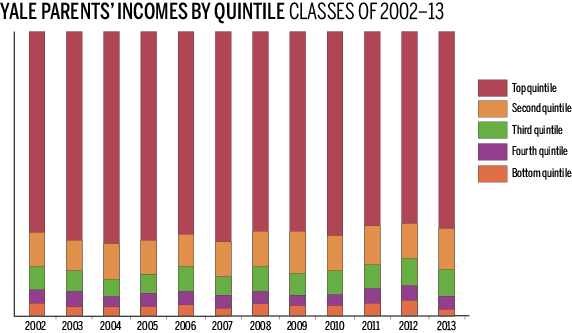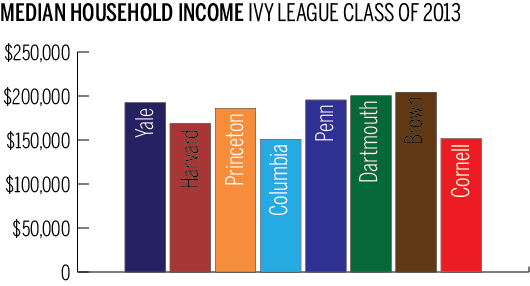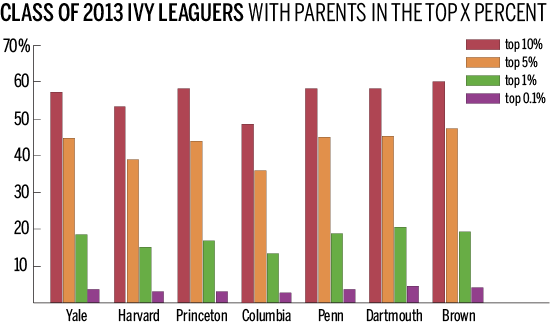
A report by The New York Times on the income distribution of U.S. college students has shed new light on income inequality at Yale.
Using data from students graduating in the years between 2002 and 2013, The New York Times found that Yale, along with four other Ivy League schools, was among 38 colleges with more students from the top 1 percent of the income bracket than from the bottom 60 percent. Roughly 18.7 percent of Yale’s class of 2013 came from a family in the top 1 percent, while 16.3 percent of the class was in the bottom 60 percent income bracket.
Using anonymous federal tax returns and attendance records, the report, which mapped the movement of students from lower to higher income brackets, was compiled by five economists studying the role of college in intergenerational mobility as part of a national effort to promote equality of opportunity nationally.
The study revealed that elite schools — which included the Ivy League as well as Duke, Stanford and the University of Chicago — have lopsided income demographics at the undergraduate level.
For students at Yale born between 1980 and 1991 — roughly corresponding to the classes of 2002 to 2013 — approximately 70 percent of Yale students came from families with household incomes in the top 20 percent. By contrast, between 2 and 5 percent of Yale students came from the bottom 20 percent. In this 11-year period, the income distribution of Yale students remained largely unchanged year to year.
This pattern is not unique to Yale: Top schools tend to enroll more students in families in the top 1 percent than they do from the entire bottom half of the income distribution. Overall, only 3.8 percent of students at top colleges come from the bottom quintile of the income distribution, according to the study.

The result? Students with parents in the top 1 percent are 77 times more likely to attend an elite school than those with parents in the bottom 20 quintile.
At Yale, even among the upper quintile, the income distribution was highly skewed towards the top percentiles. In some years the average income was as much as four times greater than the median income, indicating the extent of the inequality.
The data in the study also provided no evidence for the so-called “missing middle” — “the hypothesis that students from the middle class may be underrepresented at elite private schools, since low-income students receive substantial financial aid and high-income students have ample resources,” as defined in the study.
Previous studies have also shown that students from low-income families who are admitted to selective colleges are not placed out of their depth, because these students do nearly as well as students from more affluent backgrounds.
And, as the report’s authors note, the findings of the report further “challenge the perception that colleges foster interaction between children from diverse socioeconomic backgrounds.”
Serge Zenisek ’11, a middle school teacher in Harlem, said the report surprised him because he did not feel a significant lack of socioeconomic diversity as a Yale student.
“The student body at Yale never seemed particularly uniformly wealthy to me while I was there,” Zenisek said. “That being said, I don’t think these data are inaccurate — they just don’t reflect noneconomic forms of diversity.”
Dean of Undergraduate Admissions Jeremiah Quinlan said he and his colleagues had reviewed the research presented by the report with “great interest.” He also praised the report for “shining a light on what [New York Times columnist] David Leonhardt ’94 calls ‘working-class colleges’ that provide an outstanding ladder of mobility for lower-income students.”
Quinlan said that some of the results encouraged him, especially data that indicated that “regardless of students’ socioeconomic status when they enroll, Yale students overwhelmingly do very well for themselves after graduation.”
As Quinlan noted, the statistics roughly correspond to students graduating in the classes of 2002 to 2013, representing the admissions cycle through 2009. Quinlan added that the data from the report was “relatively old,” and does not take into account the Office of Undergraduate Admissions’ recent efforts to increase opportunity and socioeconomic diversity.
Quinlan also stressed that the report does not take into account the international students at Yale — many of whom Quinlan said receive substantial financial support.
“This … would increase our reported percentage of low-income students in reports like this,” Quinlan said. “But I do think it would also more accurately reflect the socioeconomic diversity of the students on each campus.”
Quinlan further argued the report does not reflect the office’s recent efforts to attract low-income students. He added that the internal Admissions Office data shows an increase in low-income students enrolled at Yale. For instance, from the class of 2013 to the class of 2017, the percentage of Pell Grant eligible students increased from 13 to 18 percent, Quinlan said.

Bernard Stanford ’17, who shared The New York Times article on the Facebook group Overheard at Yale, said he thinks the report was trying to measure something “a little different than what many people might be interested in.”
“It looked at what percentage of students were upwardly mobile, rather than how effective Yale was at adding to upward mobility,” Stanford said. As he explained, Yale does not have many students from the bottom quintile, but, of those students, the report showed that almost all of them made it to the top quintile post-graduation.
“Yale can and is doing things to even it out a little, but there’s a limit to what one school can do to correct the nationwide inequities in American education,” he said.
According to The New York Times, midtier public colleges, such as those that make up the City University of New York, have the highest mobility rates.







